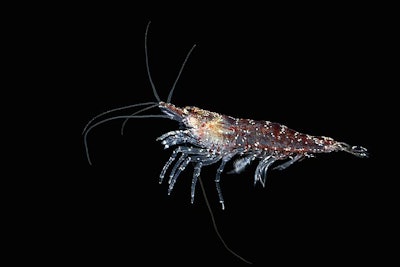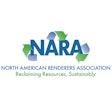
Krill, tiny marine crustaceans, provide omega-3 fatty acids for pet foods in a different form than omega-3s in conventional fish sources. That chemical difference may improve the effectiveness of omega-3 fatty acids from krill in dog foods.
“Omega-3 polyunsaturated fatty acids are beneficial to canine diets, but the source of the omega-3s can impact uptake into cell membranes,” said study co-author Lena Burri, Ph.D., director of animal nutrition and health research and development for Aker Biomarine, a krill-based pet food ingredient producer. “The key differentiator between the two marine-sourced dietary supplements is that the majority of krill-derived omega-3s are bound to phospholipids, while omega-3s from fish oil are bound to triglycerides.”
Burri and other researchers working for Aker Biomarine conducted an experiment using twenty Alaskan Huskies to test the efficacy of krill-based pet food ingredients. One group of ten dogs ate an extruded kibble diet supplemented with 1.7 grams of omega-3fatty acids from krill meal for six weeks. The omega-3 fatty acids included both eicosapentaenoic acid (EPA) and docosahexaenoic acid (DHA). Another ten dogs ate the same diet supplemented with 1.7 grams of EPA and DHA omega-3 fatty acids from fish oil. EPA levels increased in the krill meal group from 1.84% to 4.42% compared to the fish oil group, which increased from 1.90% to 2.46%. Overall, the group of dogs eating krill-based ingredients increased their omega-3 index from 3.9% at to 6.3%. The fish-based omega-3 fatty acid group increased from 3.9% to 4.7%.
“Our study aimed to measure the differences between the two, in terms of which is the most effective when it comes to uptake into red blood cell membranes,” Burri said. “This is of importance, since an increased omega-3 fatty acid tissue content will affect many biochemical and physiological functions in dogs that can result in health benefits for example skin, heart, liver and the immune system.”
Companion animal researchers have found evidence of omega-3 fatty acids helping with skin and coat conditions. Omega-3 fatty acids may support the immune system to prevent disease, while reducing heart and kidney failure. In early life, omega-3 fatty acids help nervous system development. At the other end of life, the chemicals may mitigate aging’s effects on cognition and other systems.
“This study has shown that the phospholipid-bound omega-3s from krill are more effective in raising omega-3 levels in a dog’s body compared to triglyceride-bound omega-3s, such as those found in fish oil,” she said. “Our research concluded that just six weeks of an 8% krill meal supplemented diet for dogs was an efficient way to increase the levels of the omega-3 polyunsaturated fatty acids (DHA and EPA), which implies that phospholipids serve as a more effective means to deliver omega-3s versus triglyceride-bound omega-3s.
“Phospholipid omega-3s are easy for a pet’s body to transport and incorporate into cell membranes in tissues and vital organs, where they are needed the most,” she said. “On the contrary, other sources of omega-3s in triglyceride form must be re-built into phospholipids before they can be taken up by the pet’s cells. The triglycerides are also more prone to be used as energy or fat storage, and vital omega-3s can therefore be lost instead of ending up in the cells where they affect health. As krill provides EPA and DHA mainly in the form of phospholipids and since phospholipids are structurally different than omega-3 triglycerides (found in fish and algae), this difference dictates how EPA and DHA enters into the body.”
Ecological sustainability of krill in pet food
Those omega-3 fatty acids entered the krills’ bodies from plant-like phytoplankton the tiny crustaceans consumed while swimming in world’s oceans. Krill can form vast swarms and live in all Earth’s oceans as one of the most abundant species on the planet. Predators, such as baleen whales, fish and humans, then eat the krill and pass the omega-3 fatty acids up the food chain.
As a keystone species for marine ecosystems, krill abundance directly influences many other animals, including humans, who both harvest the krill directly and the fish that eat the krill. Human harvesting of Antarctic krill peaked in the 80s, then declined after 1993’s Convention for the Conservation of Antarctic Marine Living Resources (CCAMLR). This Convention set a maximum catch for a sustainable exploitation of Antarctic krill. Currently, the annual catch of krill falls far short of this limit.
“Over the last four years, the total catch ranged between 230,000 to 390,000 tonnes annually, representing less than 0.5% of the unexploited biomass,” Burri said. “While annual variability in sea ice cover causes variation in recruitment, the estimated biomass of krill has increased from 60.3 million tonnes measured in 2000 to 62.6 million in 2018/19 according to findings from CCAMLR.”
Sustainable Fisheries Partnership classified the Antarctic krill - Atlantic Southern Ocean fishery as in very good condition. The area has had Marine Stewardship Council (MSC)-certified fisheries since 2010.
Aker Biomarine’s krill products, including QRILL Pet, are Marine Stewardship Council and Friends of the Sea certified sustainable, Burri said.
Unlike many other fisheries, Antarctic krill may be protected from overfishing. However, limiting harvests can’t mitigate the risk to krill from human activities that contribute to climate change. As the polar regions warm faster than the rest of the planet, scientists have been studying the effects of climate change on Antarctic plankton. At least one species has moved further south during the past 90 years, according to scientists writing in Nature Climate Change.
While krill provide health benefits to humans and their pets, humans threaten krill populations and the ecosystems that depend on the tiny animals, despite protections against overharvesting.
Learn more at Petfood Forum
Learn more from Dr. Burri at Petfood Forum 2021 during the roundtable discussion, “New ingredient research roundup: Omega-3 phospholipids versus triglycerides in Alaskan Huskies.” Petfood Forum provides learning and networking opportunities regardless of experience level. Pet food professionals from around the world come together to network, exchange ideas and move business forward with one another and with the industry's leading pet food suppliers and manufacturers.
Register for Petfood Forum
Petfood Forum serves the global pet food manufacturing industry. The in-person and on-demand event delivers the opportunity to learn about pet nutrition, global pet food market growth, pet food safety, processing, packaging and more, all from leading, recognized pet food industry experts














